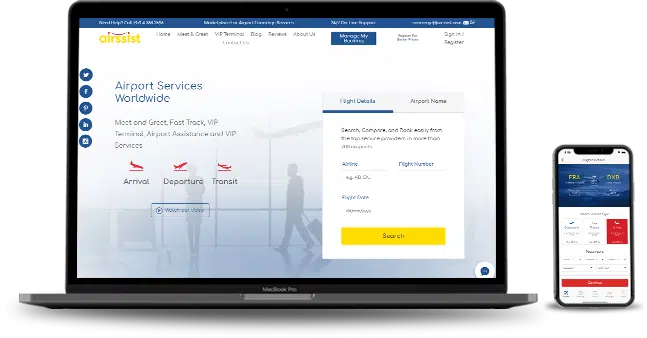Table of Contents
It is not just road traffic that’s increasing but air traffic too. With airlines announcing more flights, the cabin luggage rules are strengthening too. Gone are those days when packing was a breeze. Hand luggage restrictions have made packing today is an art. We need to keep a track of carry on bag size and weight for different airlines. But like always airssist here to the rescue. At the airport we assist you with your luggage with our porter service. And for your hand luggage we provide you the guide for cabin luggage rules.
Let’s Start With What You Should Not Pack in Your Cabin Luggage
- Obviously, no weapons. No matter what you’re carrying it for!
- No tools. You might be thinking why would I carry a tool? You might have shopped on your vacation for some carpentry things. And though it‘s harmless and I can carry it in your hand luggage. But hand luggage rules mandate no tools on board.
- Be extra careful about the amount of liquid in your hand luggage. unless its too important carry your shampoos, moisturizers, etc. in your check-in luggage. Even your meds, make sure you’re carrying it in small containers. The amount of liquids allowed in hand luggage should not exceed 100 ml.
- No sharp objects. Which you can carry small scissors, nail clippers, tweezers. You cannot carry folding knives and razor blades.
- And no, you can’t carry your favorite cutlery in hand luggage.
What is Forbidden in Hand Luggage?
The specific regulations regarding prohibited items in carry-on luggage can vary depending on the country and the airline. However, certain common items are generally prohibited in carry-on luggage for reasons of safety and security. Here are some illustrations:
Liquids exceeding a specified volume:
In many countries, there are restrictions on the quantity of liquids you may bring in your carry-on luggage. Typically, liquids must be contained in containers no larger than 100 milliliters (3.4 ounces) and all containers must fit into a single clear, resealable plastic bag. There may also be restrictions on the total volume of liquids per passenger, such as 1 liter (1 quart).
Sharp things:
knives, scissors, and razor blades are prohibited in carry-on luggage. Exceptions exist, however, for tiny shears with rounded tips or blades shorter than a certain length. These restrictions are intended to prevent the use of armaments on board.
Armes and firearms:
In hand luggage, firearms, ammunition, and other weapons are strictly prohibited. They must be declared, packaged, and conveyed in accordance with the airline’s and country’s regulations.
Explosives and combustible substances:
In general, explosives, pyrotechnics, flammable gases, and flammable liquids are not permitted in carry-on luggage. This includes petroleum, aerosol containers, and lighter fluid.
Athletic equipment:
Due to their potential for use as weapons, certain sporting equipment, such as baseball bats, golf clubs, and hockey poles, may be prohibited in carry-on luggage. Nevertheless, some airlines may permit them as checked cargo.
Tools:
In general, tools that could be used as weapons, such as hammers, wrenches, and screwdrivers, are not permitted in carry-on luggage. These goods must be transported in checked baggage.
It is important to note that these regulations are subject to change, so it is always advisable to consult the specific guidelines provided by your airline or the appropriate aviation authorities before you travel.
Check out the Hand Luggage Rules for Major Airlines in the World
Air India, Air Asia, Air France, All Nippon Airway, American Airlines, British Airways, Cathay Pacific, Delta, Emirates Airlines, Etihad Airways, EVA Air, Japan Airlines, KLM, Lufthansa, Qantas, Qatar Airways, Singapore Airlines, Thai Airways, Turkish Airlines
| Airline | Number | Size (cm) | Weight (kg) | Personal Item | Note |
|---|---|---|---|---|---|
| Air Canada | 1 | 55 x 40 x 23 | varies (10-11 lbs) | 17 x 13 x 6 | Economy weight depends on fare class |
| Air China | 1 | 55 x 40 x 20 | 5 | 1 (unspecified size) | Economy weight applies to both bags combined |
| Air France-KLM | 1 | 55 x 35 x 25 | 12 | 40 x 30 x 20 | Varies by fare class and route |
| American Airlines | 1 | 56 x 36 x 23 | 8.2 | 40 x 30 x 20 | Varies by fare class and route |
| British Airways | 1 | 56 x 45 x 25 | 7 | 40 x 30 x 20 | Varies by fare class and route |
| Cathay Pacific | 1 | 55 x 40 x 23 | 7 | 1 (unspecified size) | Economy weight applies to both bags combined |
| Emirates | 1 | 55 x 38 x 20 | 7 | 55 x 38 x 20 | Economy weight applies to both bags combined |
| Ethiopian Airlines | 1 | 55 x 35 x 25 | 8 | 40 x 30 x 20 | Varies by fare class and route |
| Etihad Airways | 1 | 55 x 40 x 23 | 7 | 40 x 30 x 20 | Varies by fare class and route |
| EVA Air | 1 | 55 x 40 x 23 | varies (8-10 kg) | 40 x 30 x 20 | Economy weight depends on fare class |
| Japan Airlines | 1 | 55 x 40 x 25 | 10 | 40 x 30 x 20 | Varies by fare class and route |
| Korean Air | 1 | 55 x 40 x 23 | 10 | 40 x 30 x 20 | Varies by fare class and route |
| Lufthansa | 1 | 55 x 40 x 23 | 8 | 40 x 30 x 20 | Varies by fare class and route |
| Qatar Airways | 1 | 55 x 38 x 20 | 7 | 40 x 30 x 20 | Economy weight applies to both bags combined |
| Singapore Airlines | 1 | Varies (max linear inches 45) | 7 | 40 x 30 x 20 | Varies by fare class and route |
| Swiss International Air Lines | 1 | 55 x 40 x 23 | 8 | 40 x 30 x 20 | Varies by fare class and route |
| Turkish Airlines | 1 | 55 x 40 x 23 | 8 | 40 x 30 x 20 | Varies by fare class and route |
| United Airlines | 1 | 56 x 36 x 23 | 7.7 | 40 x 30 x 20 | Varies by fare class and route |
Can I Take 2 Bags as Hand Luggage?
The allowance for the number of bags you can take as hand luggage can vary depending on the airline and their specific policy. In general, most airlines allow passengers to bring one carry-on bag and one personal item on board.
The carry-on bag is typically a larger bag that you can store in the overhead compartment of the aircraft. The size and weight restrictions for carry-on bags can vary, but they are usually limited to dimensions such as 22 x 14 x 9 inches (56 x 36 x 23 cm) and a weight limit of around 15 to 22 pounds (7 to 10 kilograms).
The personal item is a smaller bag or item that you can keep under the seat in front of you. This can include a purse, laptop bag, briefcase, or small backpack. The dimensions and weight restrictions for personal items are generally more flexible, but it’s still a good idea to check with your airline for any specific limitations.
It’s important to note that some airlines may have stricter policies regarding the number and size of bags allowed as hand luggage. It’s always a good idea to check the specific guidelines provided by your airline to ensure compliance and avoid any potential issues or additional charges at the airport.
Need Help With Your Luggage?
To ensure that you sail smoothly through the airport you can book Meet and Greet from airssist. What your selected package doesn’t have porter service? Worry not. You can easily add porter service as an add on to your selected package.
Frequently Asked Questions
The size and weight restrictions for hand luggage can vary depending on the airline. Typically, carry-on bags should have dimensions around 22 x 14 x 9 inches (56 x 36 x 23 cm). Weight limits often range from 15 to 22 pounds (7 to 10 kilograms). It’s important to check with your airline for their specific requirements.
” _builder_version=”4.24.0″ _module_preset=”default” global_colors_info=”{}”][/saswpfaqblockchild][saswpfaqblockchild faq_question=”Can I Bring Liquids in My Hand Luggage?” faq_answer=”
Liquids are generally allowed in hand luggage, but there are restrictions. In many countries, liquids must be in containers of 100 milliliters (3.4 ounces) or less, and all containers must fit into a single, clear, resealable plastic bag. Remember to check the guidelines for the maximum volume of liquids allowed.
” _builder_version=”4.24.0″ _module_preset=”default” global_colors_info=”{}”][/saswpfaqblockchild][saswpfaqblockchild faq_question=”Are Laptops and Electronic Devices Allowed in Hand Luggage?” faq_answer=”
Yes, laptops and electronic devices are typically allowed in hand luggage. However, they may need to be screened separately at the security checkpoint. It’s a good idea to check with your airline or airport for any specific instructions regarding electronic devices.
” _builder_version=”4.24.0″ _module_preset=”default” global_colors_info=”{}”][/saswpfaqblockchild][saswpfaqblockchild faq_question=”Can I Bring Sharp Objects Such as Scissors or Knives in My Hand Luggage?” faq_answer=”
Sharp objects like knives, scissors, and razor blades are generally prohibited in hand luggage. However, some airlines may allow small scissors with rounded tips or blades shorter than a certain length. It’s best to check with your airline for their specific guidelines.
” _builder_version=”4.24.0″ _module_preset=”default” global_colors_info=”{}”][/saswpfaqblockchild][saswpfaqblockchild faq_question=”Can I Bring Food or Drinks in My Hand Luggage?” faq_answer=”
Generally, solid food items are allowed in hand luggage. However, there may be restrictions on bringing certain types of food, such as liquids, gels, or items with strong odors. It’s advisable to check with your airline for any specific food-related restrictions.
” _builder_version=”4.24.0″ _module_preset=”default” global_colors_info=”{}”][/saswpfaqblockchild][saswpfaqblockchild faq_question=”Are There Restrictions on Bringing Medication in Hand Luggage?” faq_answer=”
Medications are usually allowed in hand luggage. It’s recommended to carry them in their original packaging and carry a prescription or doctor’s note, especially for liquid medications or injectable substances. However, it’s important to check the regulations of your destination country, as some medications may be subject to additional restrictions.
” _builder_version=”4.24.0″ _module_preset=”default” global_colors_info=”{}”][/saswpfaqblockchild][saswpfaqblockchild faq_question=”Can I Bring a Musical Instrument as Hand Luggage?” faq_answer=”
Airlines often have specific policies for carrying musical instruments as hand luggage. Some smaller instruments may be allowed as your personal item or may need to be placed in the overhead compartment. Larger instruments may require special arrangements or be transported as checked baggage. It’s best to check with your airline for their guidelines on musical instruments.
” _builder_version=”4.24.0″ _module_preset=”default” global_colors_info=”{}”][/saswpfaqblockchild][/saswp_divi_faqblock]
Note: Please note that the information on this page is generic & subject to change due to fluctuations in airport services. Kindly confirm service availability with our team, as offerings may vary daily.
 French | Français
French | Français Spanish | Espana
Spanish | Espana German | Deutch
German | Deutch Arabic | العربية
Arabic | العربية Chinese | 中文(简体)
Chinese | 中文(简体)  Japanese | 日本語
Japanese | 日本語 




